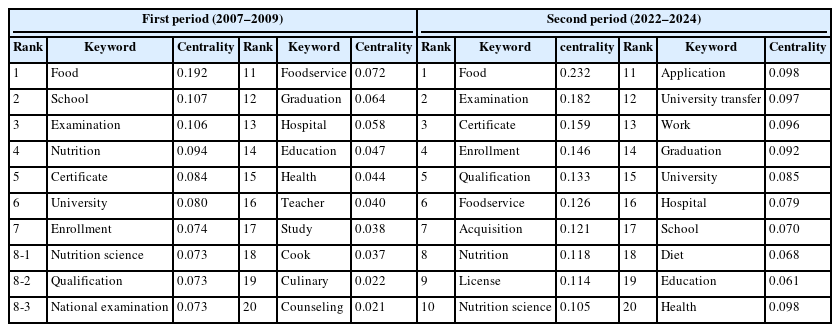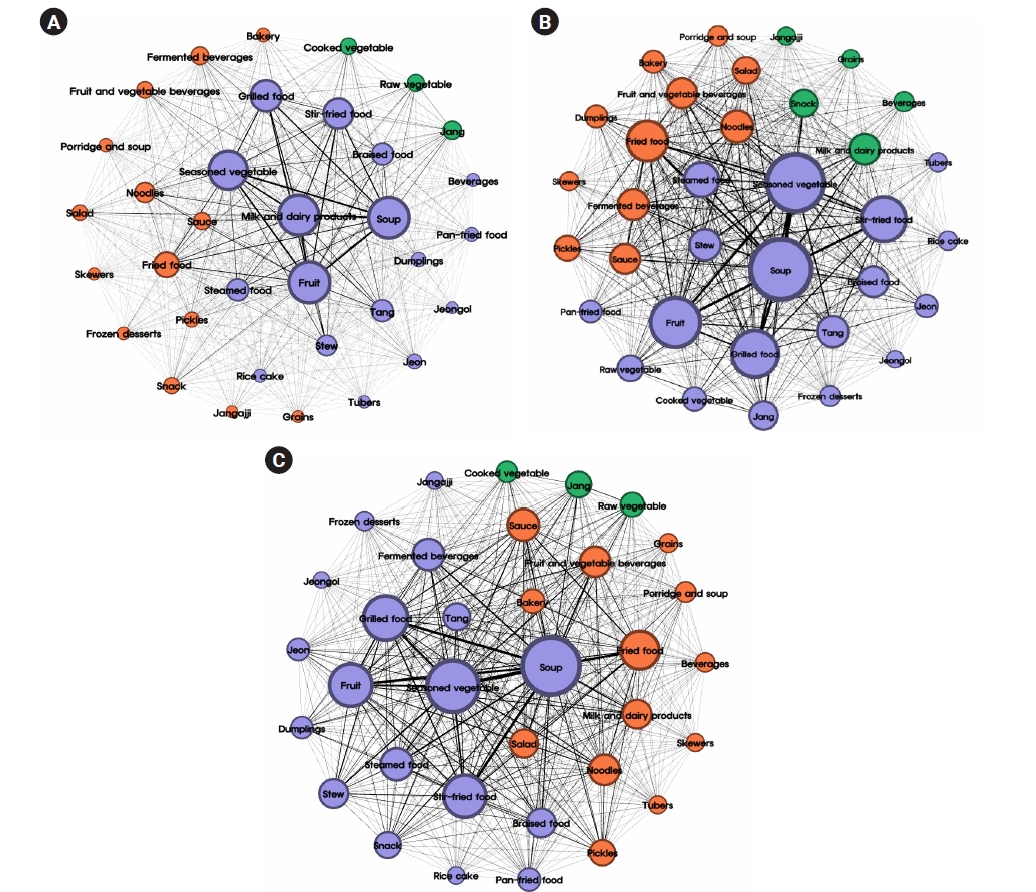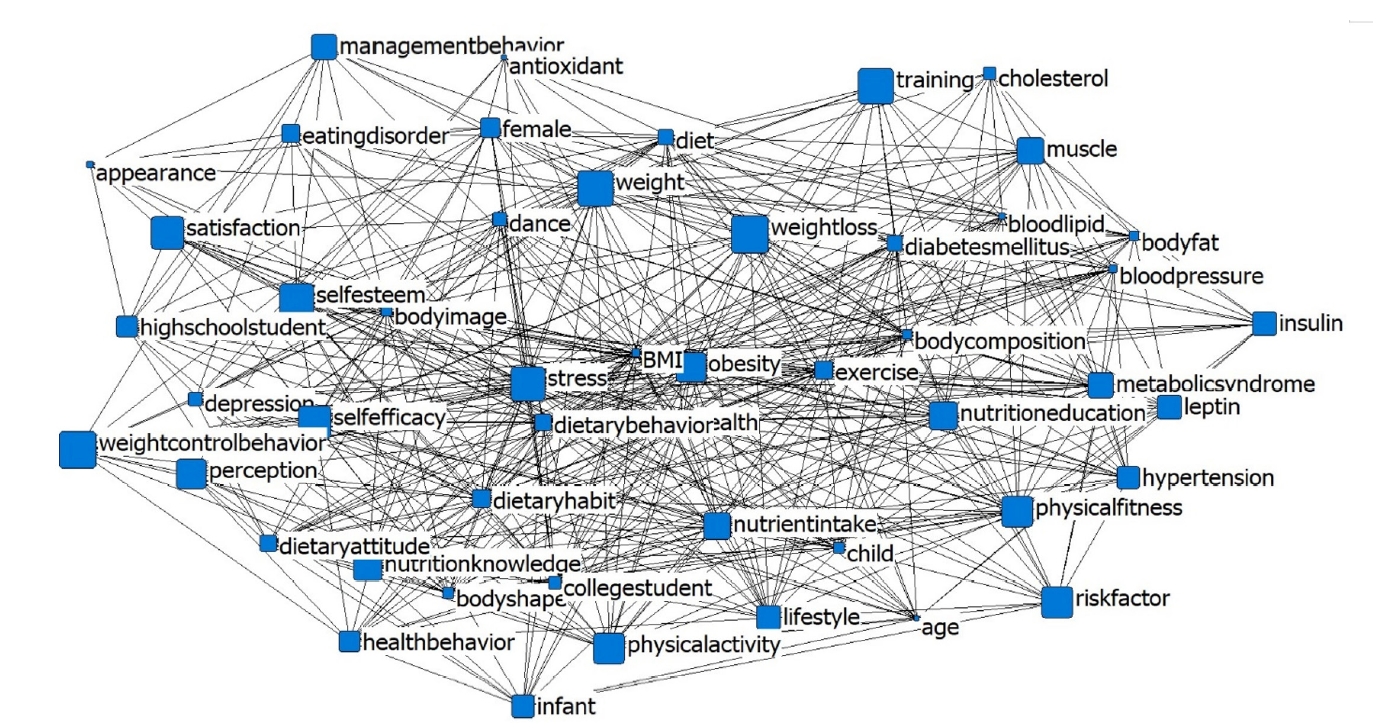Search
- Page Path
- HOME > Search
Research Articles
- [English]
- Shifting social perceptions of dietitians in Korea after the legislation of nutrition teachers: a keyword network analysis of unstructured data
- Yunkyoung Oh, Eunsil Her
- Korean J Community Nutr 2025;30(3):214-223. Published online June 30, 2025
- DOI: https://doi.org/10.5720/kjcn.2025.00045

-
 Abstract
Abstract
 PDF
PDF PubReader
PubReader ePub
ePub - Objectives
In Korea, dietitian licenses began to be issued in 1964, and they have been working to prevent diseases and promote people’s health in various fields according to the times. This study was conducted to compare differences in social perception of dietitian over time by collecting online unstructured data and analyzing the frequency and network structure of nutritionist-related keywords after the deployment of nutrition teachers began.
Methods
Using ‘dietitian’ as a keyword, we collected data from NAVER’s web, blogs, and news provided by Textom (2024, The IMC) and refined the data. We investigated the frequency ranking of keywords related to dietitians for each period, revealed the network structure using UCINET6 (Freeman) and Netdraw, and clustered similar concepts among keywords through CONCOR (CONvergence of iterated CORrelations) analysis to cluster-related concepts.
Results
Frequency analysis revealed that during the first period, keywords such as “School” and “Education” reflecting the institutionalization of nutrition teachers, were highly ranked. However, by the second period, these terms had dropped out of the top 10. Meanwhile, keywords related to healthcare, such as “Hospital”, consistently remained among the most prominent. In the second period, the rankings of the “License” and “University transfer” keywords increased significantly. Centrality analysis showed stronger connectivity between dietitians and keywords such as “Food”, “School”, “Examination”, and “Nutrition” in the second period compared to the first. CONCOR analysis further demonstrated that the “Major education” cluster of the first period was differentiated into the “Major education and qualification” and “professional competency certification process” clusters of the second period. In addition, the “Health and welfare” cluster of the first period was divided into the “Health and welfare regional service” clusters of the second period.
Conclusion
The results of this study will be used as basic data for identifying social perception and trends in the dietitian profession, further providing a scope for their improvement.
- 1,054 View
- 17 Download

- [Korean]
- Co-occurrence network and pattern of school lunch using big data and text-mining using data from the 2021–2023 school meal menu information on the NEIS open educational information portal: an exploratory study
- Hyeyun Kang, Jimi Kim
- Korean J Community Nutr 2024;29(6):514-527. Published online December 31, 2024
- DOI: https://doi.org/10.5720/kjcn.2024.00297

-
 Abstract
Abstract
 PDF
PDF Supplementary Material
Supplementary Material PubReader
PubReader ePub
ePub - Objectives
This study aimed to use big data from elementary, middle, and high school lunches to determine the primary food groups and menu items that contribute to lunch meals through text-mining and investigate the variations in food groups and menu composition patterns across different grade levels.
Methods
Between 2021 and 2023, a total of 7,892,456 lunch menus from 17 cities and provinces in South Korea were analyzed using big data from the National Education Information System (NEIS) system. After undergoing text preprocessing for text-mining, the collected menus were classified into 34 food groups based on primary ingredients and cooking methods, excluding the types of rice and kimchi. Subsequently, analyses of term frequency, term frequency-inverse document frequency (TF-IDF), centrality, and co-occurrence networks were performed on the food group and menu data.
Results
According to the TF-IDF, the most frequent food group across all grade levels was soup and seasoned vegetables, whereas milk was the most frequently provided menu. As the grade level increased, the frequency of grilled and fried food increased. In elementary schools, fruits exhibited the highest centrality, whereas soup had the highest centrality in middle and high schools. Co-occurrence frequency revealed that the soup-fruit combination was the most common in elementary schools, whereas soup and seasoned vegetables were most frequently paired in middle and high schools. The co-occurrence network of food groups and menus further indicated that menus regularly provided as standard meals and those frequently offered as special meals formed distinct communities.
Conclusion
This study investigated the food groups and menu provision patterns in school meals through text-mining techniques applied to large-scale school lunch. The findings may contribute in enhancing the quality of nutritional management, school foodservice, and menu composition of school meal programs.
- 1,184 View
- 49 Download

Review
- [English]
- Research trends relating to body weight control: a systematic review and keyword network analysis of Korea Citation Index Journals (2004–2023)
- Yunkyoung Oh, Eunsil Her
- Korean J Community Nutr 2024;29(6):445-454. Published online December 31, 2024
- DOI: https://doi.org/10.5720/kjcn.2024.00269

-
 Abstract
Abstract
 PDF
PDF PubReader
PubReader ePub
ePub - Objectives
Obesity rates are rapidly rising in Korea. Weight control is highly involved in obesity treatment. This study aimed to explore research trends related to weight control through keyword network analysis. By focusing on journals indexed in the Korea Citation Index (KCI), this study highlights trends specific to Korea, offering insights that reflect the country’s unique cultural and policy contexts in weight control research.
Methods
This study collected keywords from weight control-related papers published in the KCI journal over the past 20 years. Keywords were cleaned through Textom (2024), and the relationships between key research issue frequency analysis, structural characteristics, and keywords were identified using Textom, UCINET6, and NetDraw.
Results
Over the past 20 years, 40 to 50 studies related to weight control have been conducted each year. The Korean Journal of Community Nutrition had the largest number of published articles. Keyword frequency analysis showed that ‘obesity’ had the highest frequency. And the analysis of degree centrality and betweenness centrality, the keyword ‘obesity’ ranked the highest. CONCOR analysis identified four clusters: preventive health care, health management, physical health, and personal development.
Conclusion
The results of this study showed that weight control research reflecting the characteristics of the times has been steadily progressing in relation to the rapidly increasing obesity in Korea, and when developing policies or setting research directions related to weight loss in the future, research should be conducted in a prospective manner by subdividing it according to groups and interests.
- 1,394 View
- 37 Download

Original Article
- [English]
- Comparison and Analysis of Dieting Practices Using Big Data from 2010 and 2015
- Eun Jin Jung, Un Jae Chang
- Korean J Community Nutr 2018;23(2):128-136. Published online April 30, 2018
- DOI: https://doi.org/10.5720/kjcn.2018.23.2.128
-
 Abstract
Abstract
 PDF
PDF PubReader
PubReader - OBJECTIVES
The purpose of this study was to compare and analyse dieting practices and tendencies in 2010 and 2015 using big data.
METHODS
Keywords related to diet were collected from the portal site Naver from January 1, 2010 until December 31, 2010 for 2010 data and from January 1, 2015 until December 31, 2015 for 2015 data. Collected data were analyzed by simple frequency analysis, N-gram analysis, keyword network analysis, and seasonality analysis.
RESULTS
The results show that exercise had the highest frequency in simple frequency analysis in both years. However, weight reduction in 2010 and diet menu in 2015 appeared most frequently in N-gram analysis. In addition, keyword network analysis was categorized into three groups in 2010 (diet group, exercise group, and commercial weight control group) and four groups in 2015 (diet group, exercise group, commercial program for weight control group, and commercial food for weight control group). Analysis of seasonality showed that subjects' interests in diets increased steadily from February to July, although subjects were most interested in diets in July in both years.
CONCLUSIONS
In this study, the number of data in 2015 steadily increased compared with 2010, and diet grouping could be further subdivided. In addition, it can be confirmed that a similar pattern appeared over a one-year cycle in 2010 and 2015. Therefore, dietary method is reflected in society, and it changes according to trends. -
Citations
Citations to this article as recorded by- A Study on Diet Perceptions and Trends Before and After COVID-19 Using Big Data Analysis
Eunjung Lee, Hyosun Jung, Jina Jang
Journal of the Korean Society of Food Science and Nutrition.2023; 52(6): 659. CrossRef - Trends for weight control strategies in Korean adults using the Korea National Health and Nutrition Examination Survey from 2007 to 2017
Chunhoo Cheon, Bo-Hyoung Jang
EXPLORE.2021; 17(4): 320. CrossRef - Seasonal variation of patulous Eustachian tube diagnoses using climatic and national health insurance data
S Lee, S-W Choi, J Kim, H M Lee, S-J Oh, S-K Kong
The Journal of Laryngology & Otology.2021; 135(8): 695. CrossRef
- A Study on Diet Perceptions and Trends Before and After COVID-19 Using Big Data Analysis
- 921 View
- 6 Download
- 3 Crossref


 KSCN
KSCN

 First
First Prev
Prev



